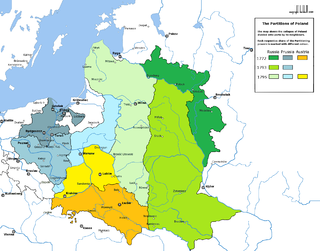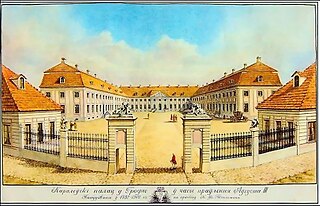 W
WThe Partitions of Poland were three partitions of the Polish–Lithuanian Commonwealth that took place toward the end of the 18th century and ended the existence of the state, resulting in the elimination of sovereign Poland and Lithuania for 123 years. The partitions were conducted by the Habsburg Monarchy, the Kingdom of Prussia, and the Russian Empire, which divided up the Commonwealth lands among themselves progressively in the process of territorial seizures and annexations.
 W
WThe First Partition of Poland took place in 1772 as the first of three partitions that eventually ended the existence of the Polish–Lithuanian Commonwealth by 1795. Growth of the Russian Empire's power, threatening the Kingdom of Prussia and the Habsburg Monarchy, was the primary motive behind this first partition.
 W
WThe 1793 Second Partition of Poland was the second of three partitions that ended the existence of the Polish–Lithuanian Commonwealth by 1795. The second partition occurred in the aftermath of the Polish–Russian War of 1792 and the Targowica Confederation of 1792, and was approved by its territorial beneficiaries, the Russian Empire and the Kingdom of Prussia. The division was ratified by the coerced Polish parliament (Sejm) in 1793 in a short-lived attempt to prevent the inevitable complete annexation of Poland, the Third Partition.
 W
WThe Third Partition of Poland (1795) was the last in a series of the Partitions of Poland and the land of the Polish–Lithuanian Commonwealth among Prussia, the Habsburg Monarchy, and the Russian Empire which effectively ended Polish–Lithuanian national sovereignty until 1918. The partition was followed by a number of Polish uprisings during the period.
 W
WFollowing three consecutive partitions of Poland carried out between 1772 and 1795, the sovereign state known as the Polish–Lithuanian Commonwealth disappeared from the map of Europe. In 1918 following the end of World War One, the territories of the former state re-emerged as the states of Poland and Lithuania among others. In the intervening period, the territory of the former Polish–Lithuanian Commonwealth was split between the Austrian Empire, the Kingdom of Prussia and the Russian Empire. These powers subdivided the territories that they gained and created new toponyms for the territories conquered. The subdivisions created were complicated by changes within those empires as well as by the periodic establishment of other forms of the quasi-Polish provinces led by a foreign head of state.
 W
WAustrian occupation of Spiš and Podhale – the Austrian occupation of the Spiš lien from 1769 until 1772, when the occupied territory was formally annexed by the Habsburg Empire, part of the First Partition of Poland. Prior to the annexation, the territory was part of Poland proper, as part of the Crown of the Kingdom of Poland.
 W
WThe Austrian Partition comprise the former territories of the Polish–Lithuanian Commonwealth acquired by the Habsburg Monarchy during the Partitions of Poland in the late 18th century. The three partitions were conducted jointly by the Russian Empire, the Kingdom of Prussia and Habsburg Austria, resulting in the complete elimination of the Polish Crown. Austria acquired Polish lands during the First Partition of 1772, and Third Partition of Poland in 1795. In the end, the Austrian sector encompassed the second-largest share of the Commonwealth's population after Russia; over 2.65 million people living on 128,900 km2 of land constituting formerly south-central part of the Republic.
 W
WDissolution of monasteries under the Russian Partition and Congress Poland - the dissolution of Catholic monasteries carried out in the nineteenth century by Russian authorities and Catholic authorities in Congress Poland and the Taken Lands.
 W
WWirydianna Fiszerowa was a Polish noblewoman best known for her memoirs, which mention her life in pre- and post-partition Poland as well as her relations with prominent people of the time, including King Frederick II of Prussia, Izabela Czartoryska, King Stanisław II Augustus, Józef Poniatowski, Jan Henryk Dąbrowski, and Tadeusz Kościuszko, whom she adored.
 W
WThe Partitions of Poland were three partitions of the Polish–Lithuanian Commonwealth that took place toward the end of the 18th century and ended the existence of the state, resulting in the elimination of sovereign Poland and Lithuania for 123 years. The partitions were conducted by the Habsburg Monarchy, the Kingdom of Prussia, and the Russian Empire, which divided up the Commonwealth lands among themselves progressively in the process of territorial seizures and annexations.
 W
WGrodno Sejm was the last Sejm of the Polish–Lithuanian Commonwealth. The Grodno Sejm, held in fall of 1793 in Grodno, Grand Duchy of Lithuania is infamous because its deputies, bribed or coerced by the Russian Empire, passed the act of Second Partition of Poland. The Sejm started on 17 June and ended on 23 November 1793. It ratified the division of the country in a futile attempt to prevent its subsequent complete annexation two years later in the 1795 Third Partition of Poland.
 W
WIncorporation of Polish children into the Imperial Russian Army occurred during and after the defeat of the November Uprising (1830–1831), when penalised Polish adolescents were incorporated into the Imperial Army of the Russian Empire.
 W
WThe Kingdom of Galicia and Lodomeria, also known simply as Galicia or Austrian Poland, was established in 1772 as a crownland of the Habsburg Monarchy as a result of the First Partition of Poland. After the Third Partition of Poland in 1795, it became a kingdom under Habsburg rule. In 1804 it became a crownland of the Austrian Empire. From 1867 it was a Polish-administered autonomous crownland under Cisleithanian Austria-Hungary, until its dissolution in 1918. The country was carved from the entire south-western part of the Polish–Lithuanian Commonwealth. Among the many ceremonial titles of the princes of Hungary was "ruler of Galicia and Lodomeria". Following the Napoleonic Wars and the Congress of Vienna, the Austrian Empire ceded portions of Galicia to the Russian Empire, West Galicia and Tarnopol District.
 W
WThe Partition Sejm was a Sejm lasting from 1773 to 1775 in the Polish–Lithuanian Commonwealth, convened by its three neighbours in order to legalize their First Partition of Poland. During its first days in session, that Sejm was the site of Tadeusz Rejtan's famous gesture of protest against Partition. The Sejm also passed other legislation, notably establishing the Permanent Council and the Commission of National Education. Cardinal Laws were confirmed.
 W
WThe Targowica Confederation was a confederation established by Polish and Lithuanian magnates on 27 April 1792, in Saint Petersburg, with the backing of the Russian Empress Catherine II. The confederation opposed the Constitution of 3 May 1791, which had been adopted by the Great Sejm, especially the provisions limiting the privileges of the nobility. The text of the founding act of the confederation was drafted by the Russian general Vasili Stepanovich Popov, Chief of Staff of Prince Grigori Alexandrovich Potemkin. Its purpose was proclaimed in the small town of Targowica and the Potocki's estate on May 14, 1792. Four days later two Russian armies invaded the Polish-Lithuanian Commonwealth without a formal declaration of war.
 W
WThe Troelfth Cake is a 1773 French allegory and satire on the First Partition of Poland. It is likely that the original title in English was intended to say "The Twelfth Cake", alluding to the division of a King Cake, but this became corrupted in later reprints. There are at least four variants of the composition, which is most common as an engraving, but also as at least one color painting; the original was likely drawn by Jean-Michel Moreau le Jeune and engraved by Nicolas Noël Le Mire. Authors of other variants included the German artist Johannes Esaias Nilson.